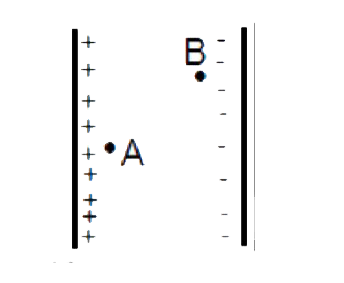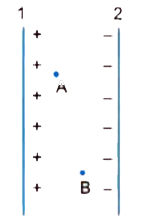Two protons A and B are placed in between the two plates of a parallel plate capacitor charged to a potential difference V as shown in the fig.4.46. Are the forces on the two protons equal?

The electric field in between the two plates of a parallel plate capacitor charged to a potential difference V is uniform everywhere. So equal forces will act on the two protons.
Topper's Solved these Questions
- CAPACITANCE AND CAPACITORBOOK - CHHAYA PUBLICATIONCHAPTER - CAPACITANCE AND CAPACITOREXERCISE - NCERT TEXTBOOK QUESTIONS
12 Videos
- CAPACITANCE AND CAPACITORBOOK - CHHAYA PUBLICATIONCHAPTER - CAPACITANCE AND CAPACITOREXERCISE - MULTIPLE CHOICE QUESTIONS
29 Videos
- CAPACITANCE AND CAPACITORBOOK - CHHAYA PUBLICATIONCHAPTER - CAPACITANCE AND CAPACITOREXERCISE - SECTION RELATED QUESTIONS
30 Videos
- ATOMIC NUCLEUSBOOK - CHHAYA PUBLICATIONCHAPTER - ATOMIC NUCLEUSEXERCISE - CBSE SCANNER
14 Videos
- COMMUNICATION STSTEMBOOK - CHHAYA PUBLICATIONCHAPTER - COMMUNICATION STSTEMEXERCISE - CBSE SCANNER
28 Videos
Similar Questions
Two protons A and B are placed in between the two plates of a parallel plate capacitor charged to a potential difference V as shown in the figure. The forces on the two protons are identical.

View SolutionTwo protons A and B are placed in between the two plates of a parallel plate capacitor charged to a potential difference V as shown in the figure. The forces on the two protons are identical.

View Solution
Knowledge Check
A proton is first placed at A and then at B between the two plates of a parallel plate capacitor charged to a P.D. of V volt as shown. Then force on proton at A is -
 Amore than at BBless then at BCequal to that at BDnothing can be said
Amore than at BBless then at BCequal to that at BDnothing can be saidThe force between the plates of a parallel plate capacitor of capacitance C and distance of separation of the plates d with a potential difference V between the plates, is.
ACV22dBC2V22d2CC2V2d2DV2dCThe force between the plates of a parallel plate capacitor of capacitance C and distance of separation of the plates d with a potential difference V between the plates, is.
ACV22dBC2V22d2CC2V2d2DV2dC
Two protons A and B are placed in between the two plates of a parallel plate capacitor charged to a potential difference Vas shown in Fig. The force on the two protons are exactly the same.

View SolutionHow will the voltage (V) between the two plates of a parallel plate capacitor depend on the distance (d) between the plates, if the charge on the capacitor remains the same?
View SolutionThe force between the plates of a parallel plate capacitor of capacitance C and distance of separation of the plates d with a potential difference V between the plates, is.
View SolutionThe plates of a parallel plate capacitor are charged to a potential difference of 117 V and then connected across a resistor. The potential difference across the capacitor decreases exponentially with to time. After 1s the potential difference between the plates is 39 V, then after 2s from the start, the potential difference (in V) between the plates is
View SolutionThe plates of a parallel plate capacitor are charged to a potential difference of 117 V and then connected across a resistor. The potential difference across the capacitor decreases exponentially with to time. After 1s the potential difference between the plates is 39 V, then after 2s from the start, the potential difference (in V) between the plates is
View Solution
